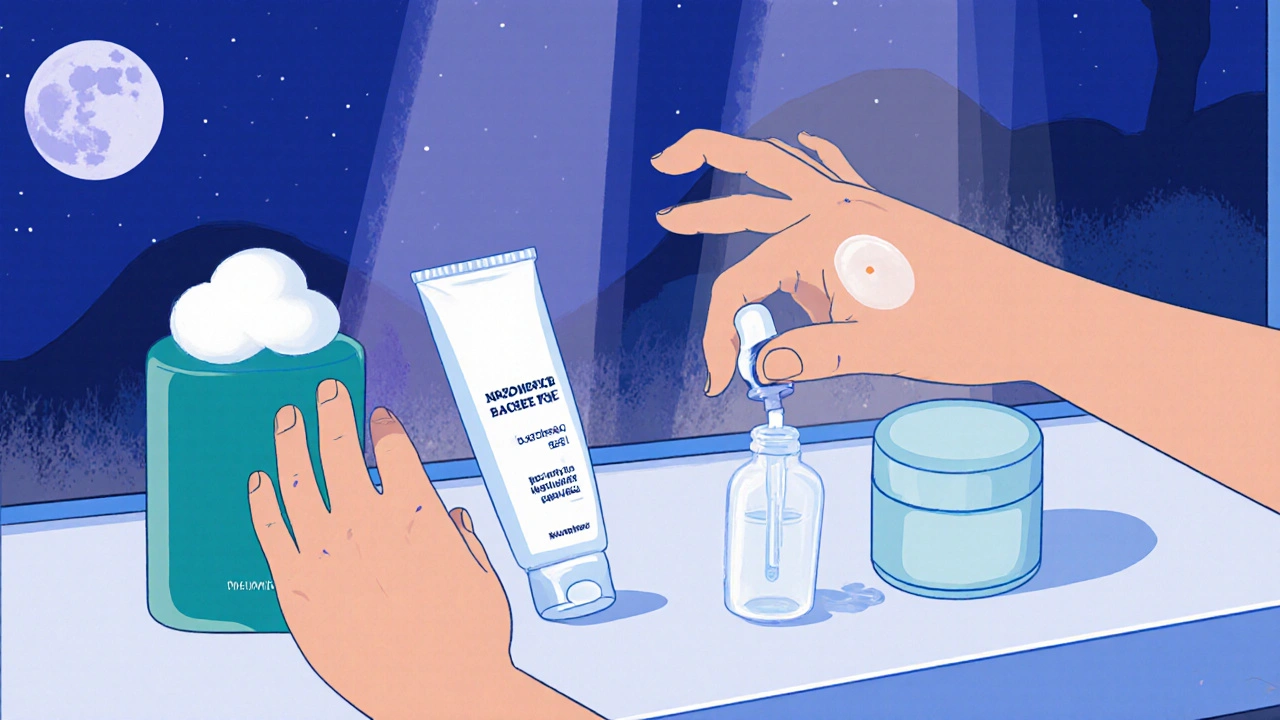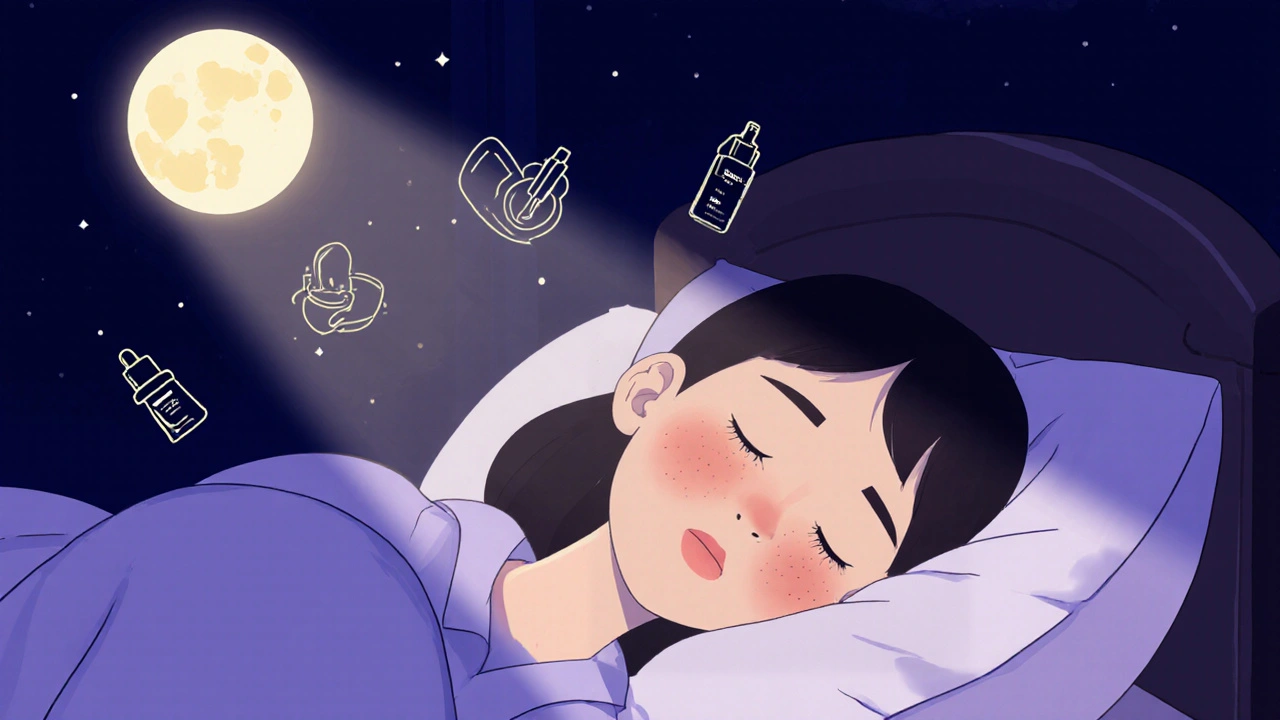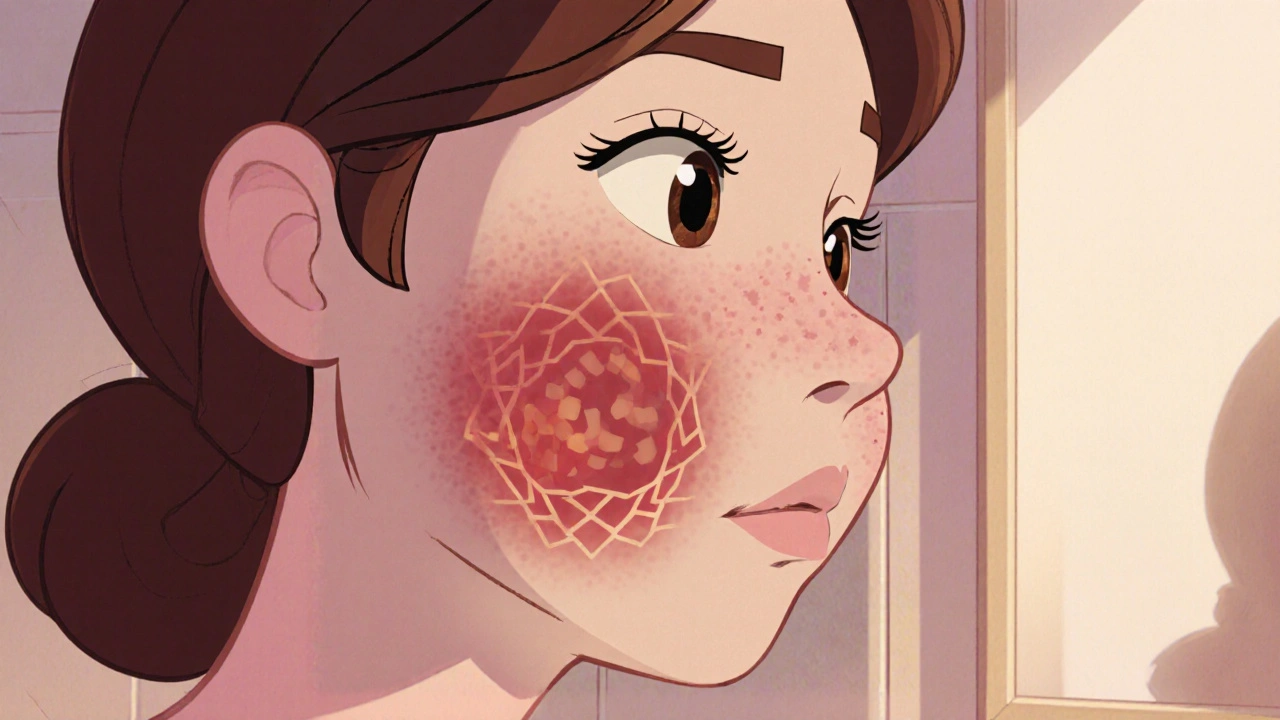When it comes to stubborn breakouts, nodular acne is a deep, inflamed type that forms large, painful lumps beneath the skin surface. Unlike surface pimples, these nodules develop when hair follicles become clogged with excess oil, dead skin cells, and bacteria, causing the surrounding tissue to swell. Because the inflammation sits deep, quick fixes often feel ineffective, but a focused overnight routine can help calm the swelling and reduce visible redness.
Quick Takeaways
- Cleanse with a gentle, pH‑balanced wash to remove excess oil without stripping skin.
- Apply a targeted spot treatment containing benzoyl peroxide or salicylic acid to the nodule.
- Use a soothing antioxidant like niacinamide to reduce inflammation.
- Finish with a lightweight, non‑comedogenic moisturizer to keep the barrier intact.
- Consult a dermatologist if nodules persist or worsen.
Understanding Nodular Acne
The key to tackling nodular acne is knowing why it forms. When sebaceous glands pump out oil, it mixes with dead keratinocytes and gets trapped inside the follicle. Benzoyl Peroxide and Salicylic Acid work differently: the former kills the acne‑causing bacteria Propionibacterium acnes, while the latter dissolves the glue that holds dead cells together. Both reduce the size of the blockage, allowing the nodule to shrink.
Why Overnight Results Are Possible
Skin repairs itself while you sleep. During the night, circulation increases, cortisol drops, and the body releases anti‑inflammatory cytokines. By delivering fast‑acting ingredients right before bed, you give these natural processes a boost. The goal isn’t to vanish the nodule in a few hours-rather, it’s to calm the inflammation enough that the bump appears smaller and less red the next morning.
Step‑by‑Step Overnight Routine
- Gentle Cleanse: Use a sulfate‑free cleanser (pH 5.5) and lukewarm water. Pat dry with a clean towel-no rubbing.
- Targeted Spot Treatment: Apply a thin layer of a benzoyl peroxide gel (2.5%-5%) or a salicylic acid solution (0.5%-2%). Let it absorb for 2‑3 minutes.
- Soothing Antioxidant: Dab a few drops of niacinamide serum (5%-10%) to calm redness and strengthen the barrier.
- Hydration Lock: Finish with a non‑comedogenic moisturizer containing ceramides or hyaluronic acid. This prevents the skin from over‑producing oil overnight.
Consistency is key. Repeat the routine each night and you should notice a visible reduction in nodule size within 3‑5 days.

Additional Overnight Enhancers
- Tea Tree Oil: A natural antiseptic. Dilute 1% in a carrier oil and apply to the nodule after the spot treatment.
- Retinoid (Adapalene): If you tolerate it, a 0.1% adapalene cream applied on alternate nights can speed up cell turnover.
- Cool Compress: A chilled gel mask for 5 minutes can shrink blood vessels and reduce redness.
- Hypochlorous Acid Spray: A low‑pH, antibacterial mist that can be sprayed lightly before bed for a quick germ kill.
Comparison of Overnight Spot Treatments
| Ingredient | Typical Strength | Primary Action | Result Timeline | Best For |
|---|---|---|---|---|
| Benzoyl Peroxide | 2.5%-5% | Antibacterial, keratolytic | 1-3 days for redness reduction | Inflamed, oily skin |
| Salicylic Acid | 0.5%-2% | Exfoliates inside pores | 2-4 days for size shrinkage | Combination, blackhead‑prone |
| Tea Tree Oil | 1%-2% (diluted) | Natural antiseptic | 3-5 days for calmness | Sensitive skin |
| Adapalene (Retinoid) | 0.1%-0.3% | Cell turnover acceleration | 1 week+ for texture improvement | Resistant nodules |
| Niacinamide | 5%-10% | Anti‑inflammatory, barrier repair | Immediate soothing, 5‑7 days for overall tone | All skin types |
Checklist: Nighttime Acne Protocol
- Cleanse with pH‑balanced formula
- Apply benzoyl peroxide or salicylic acid directly on each nodule
- Follow with niacinamide serum
- Seal with non‑comedogenic moisturizer
- Optional: add tea tree oil or retinoid on alternate nights
- Maintain consistent sleep schedule (7‑9 hrs)
- Track nodule size and redness in a simple journal

When to Seek Professional Help
If you notice any of the following, contact a dermatologist:
- Pain that worsens after a few days
- Spread of nodules to new areas
- Scarring or persistent hyperpigmentation
- Allergic reaction to any over‑the‑counter product
Professionals can prescribe oral isotretinoin, hormonal therapy, or in‑office extraction-options that go beyond what home care can achieve.
Frequently Asked Questions
Can I use benzoyl peroxide and salicylic acid together?
It’s best to alternate them-using both at once can irritate the skin. Apply benzoyl peroxide one night, salicylic acid the next.
How long does it take to see results?
Most people notice reduced redness within 24‑48 hours, and a smaller nodule size after 3‑5 nights of consistent use.
Is tea tree oil safe for sensitive skin?
Yes, if you dilute it to 1%‑2% with a carrier oil (e.g., jojoba). Undiluted oil can cause stinging.
Can I skip moisturizer if I’m using a spot treatment?
Never. Moisturizer protects the barrier, prevents rebound oil production, and actually helps spot treatments penetrate better.
What if my nodules keep coming back?
Recurring nodules often signal hormonal imbalance or an unsuitable skincare regimen. A dermatologist can order hormone panels and suggest prescription‑strength options.
Next Steps & Troubleshooting
If you follow the routine but see no improvement after a week, try these adjustments:
- Reduce benzoyl peroxide concentration to 2.5% to avoid excessive dryness.
- Introduce a gentle exfoliating toner (once daily) to keep pores clear.
- Switch to a fragrance‑free moisturizer to eliminate potential irritants.
- Set a reminder to keep bedtime consistent-irregular sleep can worsen inflammation.
Remember, the skin’s healing cycle is about 28 days. Patience, combined with the right overnight actives, will gradually make those stubborn nodules less noticeable.


14 Comments
Harry Bhullar
First off, you want a cleanser that's truly pH‑balanced, around 5.5, so you don’t strip your skin’s natural acid mantle. A sulfate‑free formula helps keep that barrier intact while still removing excess sebum and dead cells. When you hit the spot with benzoyl peroxide or salicylic acid, make sure the product dries for a couple of minutes before layering anything else. Follow up with a niacinamide serum; its anti‑inflammatory properties calm that reddening you’re fighting. Lock everything in with a lightweight moisturizer that includes ceramides to prevent rebound oil production. Consistency is king – repeat this routine nightly and you’ll start seeing a reduction in nodule size within a few days. And remember, if the nodules persist, a dermatologist can give you stronger prescription‑grade options.
Dana Yonce
I love the quick step‑by‑step, it makes things less scary 😊. The two‑minute wait before the next product is a game‑changer.
Lolita Gaela
The pharmacodynamics of benzoyl peroxide involve the generation of free radicals that oxidize bacterial proteins, effectively reducing Propionibacterium acnes load. Salicylic acid, being a beta‑hydroxy acid, penetrates the follicular epithelium to dissolve keratinous debris. When these agents are applied in the evening, they dovetail with the skin’s nocturnal reparative phase, allowing for maximal absorption. Niacinamide’s role as a substrate for NAD+ synthesis also supports cellular energy metabolism, which is crucial during sleep‑related recovery. Ceramide‑rich moisturizers replenish the lamellar layers, preventing transepidermal water loss that could otherwise trigger compensatory sebum production. Alternating benzoyl peroxide and salicylic acid on successive nights minimizes cumulative irritation while maintaining antimicrobial pressure. In practice, this synergistic protocol can attenuate inflammation and promote lesion resolution more efficiently than monotherapy.
Giusto Madison
Don’t overthink it – just stick to the schedule and you’ll see results. Alternate the actives each night, otherwise you’ll end up with flaky skin and no progress. Keep the moisturizer in the mix; skipping it is the fastest way to ruin the barrier. If you notice excessive dryness, dial the benzoyl peroxide down to 2.5 % and up the niacinamide. Your skin will thank you when you stay consistent.
erica fenty
Quick tip: keep the pH of your cleanser around 5.5 – it’s the sweet spot.
Use a non‑comedogenic moisturiser to stop your skin from over‑producing oil.
Don’t stack more than two actives at once; irritation beats improvement.
Eli Soler Caralt
Ah, the nocturnal alchemy of dermatological care – one could argue that skin, like the soul, seeks equilibrium under the moon’s quiet gaze 🌙✨. When you wield benzoyl peroxide, you’re not merely killing bacteria; you’re performing a ritual of purification, shedding the epidermal sins of excess sebum. Pair it with niacinamide, the philosopher‑king of anti‑inflammation, and you orchestrate a symphony of dermal harmony. Remember, the universe favours balance, so over‑application is the hubris of mortals. 🍃💫
Eryn Wells
In many cultures, bedtime skin rituals are a moment of self‑care and reflection. Whether you’re using tea tree oil in Japan or a herbal compress in the Mediterranean, the key is consistency and gentle ingredients. Embracing diverse traditions can help you find a routine that feels both effective and comforting. 🌍❤️
Kathrynne Krause
Let’s turn that night‑time routine into a power‑up! 🚀 Start with a calming cleanse, then unleash that benzoyl peroxide like a superhero. Follow up with a niacinamide serum to soothe the battlefield, and seal the deal with a moisturizer that keeps the skin’s shield strong. You’ve got this – each night brings you closer to clearer skin!
Chirag Muthoo
It is advisable to adhere strictly to the prescribed regimen, ensuring that each constituent product is applied in the order delineated, thereby facilitating optimal dermal restoration during the nocturnal phase. Moreover, documenting lesion dimensions on a daily basis may provide empirical evidence of therapeutic efficacy. Should any adverse reactions manifest, immediate cessation of the offending agent and consultation with a qualified dermatologist are imperative.
Angela Koulouris
Great points, Chirag! Consistency truly is the backbone of any skin‐care plan. If you ever feel the routine getting monotonous, feel free to switch up the moisturizer colour or scent – just keep the actives the same. You’ll be amazed at how much the skin appreciates that steady, supportive guidance.
Jasmina Redzepovic
Let’s get real: the mainstream skincare industry pushes overpriced products while ignoring simple, effective chemistry. If you’re serious about beating nodular acne, you need to stop buying hype and start using clinically proven actives, period. The science doesn’t lie, the marketing does.
Kimberly Lloyd
Each step you take is like planting a seed of confidence in your skin’s future. Even when the nodules seem stubborn, remember that perseverance nurtures transformation. Trust the process, and your skin will reflect the patience you invest.
John Price
Consistency beats everything.
Nick M
The first thing most people don’t realize is that the skincare market is deliberately engineered to keep you dependent on ever‑changing products, a classic profit‑driven feedback loop. When you read a label full of buzzwords like “clinical‑grade” or “dermatologist‑tested,” it’s often a veneer for proprietary blends that do little beyond moisturising. The real work lies in disrupting that cycle with ingredients that have a clear mechanism of action, such as benzoyl peroxide’s free radical generation or salicylic acid’s keratolytic properties. Yet even those are marketed as “harsh” to scare you into buying gentler, more expensive alternatives that lack efficacy. Moreover, the timing of your routine isn’t a coincidence; the industry’s recommendations often align with peak consumer online activity, ensuring maximum ad impressions. By applying actives at night, you’re actually syncing with your skin’s natural repair processes, a fact that many brands conveniently ignore in favour of brighter‑day marketing campaigns. In addition, the fog of hype around “natural” oils like tea tree often masks the fact that without proper dilution they can cause dermatitis, leading to more doctor visits and, consequently, more product sales. The endless stream of “new and improved” moisturisers is another ploy, as they add unnecessary emollients that can occlude pores, prompting breakout cycles that force you back to the store. It’s a self‑perpetuating system where each intervention begets the next, all while the underlying principle – consistent, science‑backed actives – remains unchanged. So, cut through the noise: cleanse, treat, soothe, and moisturise – repeat nightly, and you’ll see genuine results without feeding the industry’s profit engine. Remember, the simplest protocols often outlast the most elaborate hype, because real skin health doesn’t need a marketing budget, just a solid, repeatable regimen.